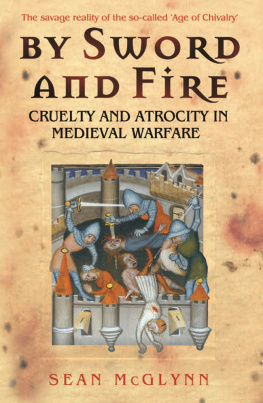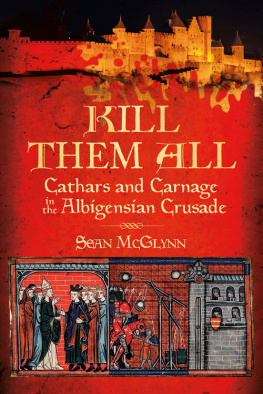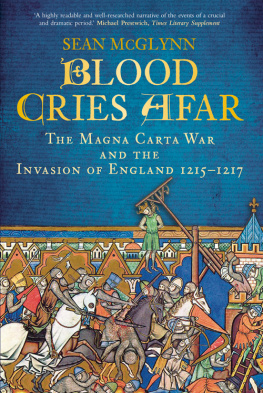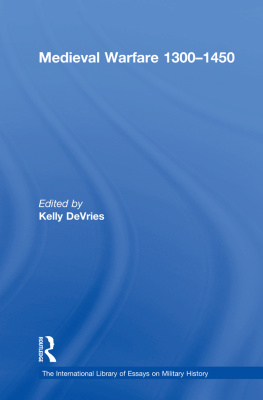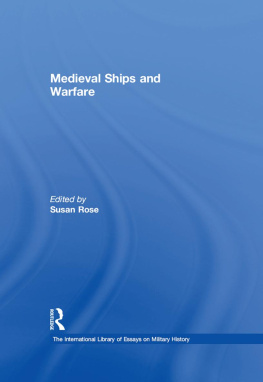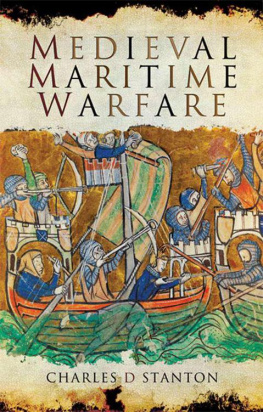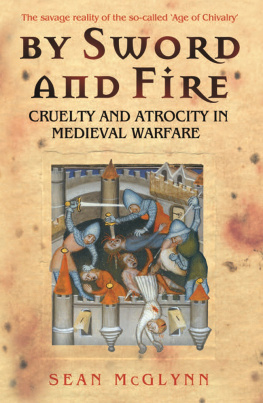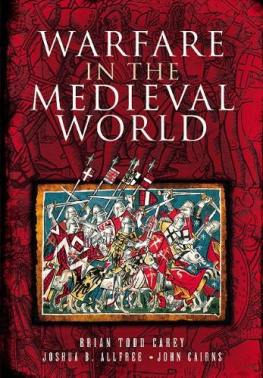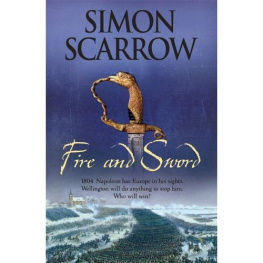McGlynn - By sword and fire: cruelty and atrocity in medieval warfare
Here you can read online McGlynn - By sword and fire: cruelty and atrocity in medieval warfare full text of the book (entire story) in english for free. Download pdf and epub, get meaning, cover and reviews about this ebook. City: Europe, year: 2014, publisher: Orion Books;Phoenix, genre: Religion. Description of the work, (preface) as well as reviews are available. Best literature library LitArk.com created for fans of good reading and offers a wide selection of genres:
Romance novel
Science fiction
Adventure
Detective
Science
History
Home and family
Prose
Art
Politics
Computer
Non-fiction
Religion
Business
Children
Humor
Choose a favorite category and find really read worthwhile books. Enjoy immersion in the world of imagination, feel the emotions of the characters or learn something new for yourself, make an fascinating discovery.
By sword and fire: cruelty and atrocity in medieval warfare: summary, description and annotation
We offer to read an annotation, description, summary or preface (depends on what the author of the book "By sword and fire: cruelty and atrocity in medieval warfare" wrote himself). If you haven't found the necessary information about the book — write in the comments, we will try to find it.
McGlynn: author's other books
Who wrote By sword and fire: cruelty and atrocity in medieval warfare? Find out the surname, the name of the author of the book and a list of all author's works by series.
By sword and fire: cruelty and atrocity in medieval warfare — read online for free the complete book (whole text) full work
Below is the text of the book, divided by pages. System saving the place of the last page read, allows you to conveniently read the book "By sword and fire: cruelty and atrocity in medieval warfare" online for free, without having to search again every time where you left off. Put a bookmark, and you can go to the page where you finished reading at any time.
Font size:
Interval:
Bookmark:

BY SWORD
AND FIRE
Cruelty and Atrocity in
Medieval Warfare
Sean McGlynn

PHOENIX
For my mother and
in memory of my father
CONTENTS
Jerusalem, 1099
When the Armistice was declared at the end of the First World War, a conflict that had left over eight million dead, the poet Sir Henry Newbolt rather crassly exhorted his readers: Think of chivalry victorious. The myth of chivalry has proven persistent. The allure of Chaucers verray, parfit gentil knyght remains irresistible for its image of a powerful warrior devoted to the ideals of bravery, honour, loyalty and self-sacrifice, all in the service not just of his lord or lady, but also for his role as protector of the weak, the elderly, the young and the defenceless. That Chaucer could describe his knight in such terms appears initially to military historians as a contradiction in terms: a gentle knight was not much use on the battlefield. Chaucer was writing in the second half of the fourteenth century, at a time when the ravages of the Hundred Years War and violent peasant uprisings had racked England and France with breathtaking brutality, as we shall see. Chaucer, with his high connections and travels across Europe, was well aware of these brutalities. His parfait, gentil knyght was a call to an idealized version of knighthood, prompted by the horrors of endemic warfare and social unrest.
Chaucer was following in the tradition of a long line of medieval writers who sought to mitigate the excesses of war in the Middle Ages through an appeal to the nobler instincts of knights. This literary genre is the subject of Richard W. Kaeupers book, Chivalry and Violence in Medieval Europe (1999), in which the author explores medieval writers attempts at reform in calling for a return to the true values of chivalry. However, at the same time, other writers were calmly accepting or, indeed, were encouraging the waging of war against non-combatants as the most practical way to achieve victory, even going so far as to justify these measures as being in accordance with chivalric values. The pragmatists retained their ascendancy over the idealists. This book examines what this meant for non-combatants in the wars of the Middle Ages and explains the rationale the military imperative that lay behind the atrocities committed.
I began studying medieval warfare in London just over twenty years ago, at a time when the revisionist school of medieval military historians there was making its important researches known. There are few who now believe that warfare in the Middle Ages was an amateurish and haphazard affair. However, the military atrocities of the age are still too frequently regarded as the natural outbursts of a violent age. The limitations of chivalry and the reality of medieval warfare have been the subject of exceptional scholarship by such medievalists as John Gillingham, Matthew Strickland and Christopher Allmand. This scholarship is deservedly acknowledged in academic circles, and at times I have drawn heavily on their work in their own particular fields. But the very nature of such research has perforce meant that it has been tightly focused in terms of period and region and that its audience has predominantly been a narrow, academic one. (Matthew Stricklands outstanding War and Chivalry: The Conduct and Perception of War in England and Normandy, 10661217 (Cambridge University Press, 1996) is especially worthy of note here, not least because the research originally in the shape of a PhD thesis has taken the form of a book, albeit one designed for an academic readership.)
In this book I attempt to present the findings of recent research, including my own, in an accessible way to a broader readership that will demonstrate clearly that medieval atrocities were not simply the result of ill-disciplined soldiers sating their blood lust, or the abhorrent acts of aberrant knights acting out of character. I explain these atrocities in detail within their immediate and more general military context. In its geographical and chronological scope ranging across the whole Middle Ages and the Latin world to encompass the crusading movement in the Middle East I believe that this is the first book of its kind on this important subject.
The savagery of medieval warfare is widely acknowledged and understood; yet the idea of chivalry as an important and influential force in the conflicts of the Middle Ages somehow lives on in seemingly comfortable juxtaposition with this awareness. In By Sword and Fire I show that such notions of incongruent compatibility do not reflect the reality of the times. As far as the practicalities of war are concerned, chivalry has been showered with too much attention. It represented but one small facet of medieval warfare; for non-combatants, it was so small a part of warfare as to be inconsequential. Although, as Malcolm Vale has shown in his important study War and Chivalry: Warfare and Aristocratic Culture in England, France and Burgundy at the End of the Middle Ages (1981), chivalry remained (with notable exceptions, I would argue) practical and flexible for the nobility at war throughout the medieval period, for non-combatants it remained, as I hope to show, pretty much as irrelevant as it had always been. Chivalry was a cult and a code for a small elite; it was not designed for the masses in warfare, be they ordinary soldiers or non-combatants.
This book, then, concerns itself not with chivalry but with warfare, with the realities of conflict and what it meant for non-belligerents. The chapters on atrocities are introduced with a brief explanation of how the central operations of warfare battles, sieges and campaigns were conducted and the role they played within overall strategy. In this way, the background to the atrocity can be understood in the light of the overriding military imperative.
No less importantly, I wish to emphasize that the atrocities described by medieval chroniclers were not merely the excitable outpourings of monkish hyperbole submerged in biblical and religious symbolism; rather, for all the undoubted exaggerations of many of these accounts, they reflect the reality and brutality of medieval warfare as the great figures of chivalry pursued their military objectives by whatever bloody means they deemed necessary.
When I had just finished writing this book, I began reading George Orwells essays. In his reflections on the Spanish Civil War of the 1930s, he comments on atrocity stories with his usual lucidity and perspicacity. These comments are reprinted at the beginning of this book; they summarize perfectly its conclusions.
Sean McGlynn
October 2007
A first book is traditionally the one most laden with acknowledgements. I shall not break with tradition. Academically, I obviously owe much to my teachers. In approximately reverse chronological order, I have been fortunate enough to study medieval history under Professors Peter Cross, John Gillingham, Janet Nelson, R. Allen Brown, David DAvray and Christopher Harper-Bill. Fruitful and highly enjoyable sorties into the sixteenth century and the world of teaching have been made under the guidance of Dr Susan Doran, Dr Michael Ryan and, right at the very beginning, Mr Tom Moran, who will be very surprised if this book ever falls into his hands: it was his small sixthform library of Elton, Elliot, Hale and Parker that helped to start it all.
Over the years, while chiefly preoccupied with many other diversions, I have benefited greatly from the help and insights of many medievalists, whether through conversations and invitations to speak at seminars and conferences, or through correspondence and the provision of publications in advance. These include Andrew Ayton, Matthew Bennett, David Crouch, John France, Alexander Grant, Len Scales, Matthew Strickland and Bjorn Weiler.
Font size:
Interval:
Bookmark:
Similar books «By sword and fire: cruelty and atrocity in medieval warfare»
Look at similar books to By sword and fire: cruelty and atrocity in medieval warfare. We have selected literature similar in name and meaning in the hope of providing readers with more options to find new, interesting, not yet read works.
Discussion, reviews of the book By sword and fire: cruelty and atrocity in medieval warfare and just readers' own opinions. Leave your comments, write what you think about the work, its meaning or the main characters. Specify what exactly you liked and what you didn't like, and why you think so.

